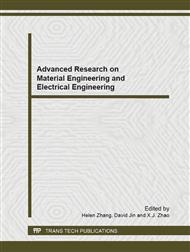p.289
p.293
p.297
p.302
p.306
p.312
p.321
p.325
p.330
Design and Implementation of Synchronous Wireless On-Line Detection System of MOA Resistive Current in Electric Power System Based on GPS
Abstract:
Metal oxide arresters (MOA) are important apparatus defending electric power systems against lightning strikes. The resistive current value of MOAs can reflect equipment status better. In conventional methods measuring resistive current of MOAs, wires need to be connected to the secondary side of voltage transformer during each test, and this brings great safety risks. A new wireless method is proposed to measure resistive current of MOAs. Based on GPS and wireless transmission module, wireless synchronous measurement of portable current detector and voltage monitor can be implemented. Fourier Sequence algorithm is applied to detect the resistive current of MOA. System compositions, design and methods of hardware implementation is focused on in this paper. Lab experiment and on-site testing results show that the method is satisfactory.
Info:
Periodical:
Pages:
312-317
Citation:
Online since:
March 2013
Authors:
Keywords:
Price:
Сopyright:
© 2013 Trans Tech Publications Ltd. All Rights Reserved
Share:
Citation:


